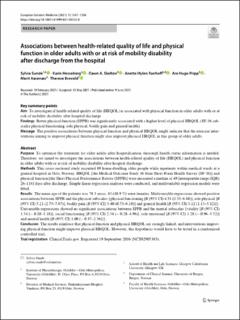| dc.contributor.author | Sunde, Sylvia | |
| dc.contributor.author | Hesseberg, Karin | |
| dc.contributor.author | Skelton, Dawn A. | |
| dc.contributor.author | Ranhoff, Anette Hylen | |
| dc.contributor.author | Pripp, Are Hugo | |
| dc.contributor.author | Aarønæs, Marit | |
| dc.contributor.author | Brovold, Therese | |
| dc.coverage.spatial | Norway, Oslo | en_US |
| dc.date.accessioned | 2022-08-02T13:07:07Z | |
| dc.date.available | 2022-08-02T13:07:07Z | |
| dc.date.created | 2021-07-06T12:02:19Z | |
| dc.date.issued | 2021-06-09 | |
| dc.identifier.citation | European Geriatric Medicine. 2021, . | en_US |
| dc.identifier.issn | 1878-7649 | |
| dc.identifier.issn | 1878-7657 | |
| dc.identifier.uri | https://hdl.handle.net/11250/3009805 | |
| dc.description.abstract | Purpose: To optimise the treatment for older adults after hospitalisation, thorough health status information is needed. Therefore, we aimed to investigate the associations between health-related quality of life (HRQOL) and physical function in older adults with or at risk of mobility disability after hospital discharge.
Methods: This cross-sectional study recruited 89 home-dwelling older people while inpatients within medical wards at a general hospital in Oslo, Norway. HRQOL [the Medical Outcome Study 36-Item Short-Form Health Survey (SF-36)] and physical function [the Short Physical Performance Battery (SPPB)] were measured a median of 49 [interquartile range (IQR) 26–116] days after discharge. Simple linear regression analyses were conducted, and multivariable regression models were ftted.
Results: The mean age of the patients was 78.3 years; 43 (48.9 %) were females. Multivariable regressions showed positive associations between SPPB and the physical subscales {physical functioning [B (95% CI) 4.51 (2.35–6.68)], role physical [B (95% CI) 5.21 (2.75–7.67)], bodily pain [B (95% CI) 3.40 (0.73–6.10)] and general health [B (95% CI) 3.12 (1.13–5.12)]}. Univariable regressions showed no signifcant associations between SPPB and the mental subscales {vitality [B (95% CI) 1.54 (− 0.10–3.18)], social functioning [B (95% CI) 2.34 (− 0.28–4.96)], role emotional [B (95% CI) 1.28 (− 0.96–3.52)] and mental health [B (95% CI) 1.00 (− 0.37–2.36)]}.
Conclusion: The results reinforce that physical function and physical HRQOL are strongly linked, and interventions improving physical function might improve physical HRQOL. However, this hypothesis would have to be tested in a randomised controlled trial. | en_US |
| dc.description.sponsorship | Open access funding provided by OsloMet - Oslo Metropolitan University. This research received external funding from the Norwegian Fund for Post-Graduate Training in Physiotherapy. Internal founding is provided by Oslo Metropolitan University (OsloMet). | en_US |
| dc.language.iso | eng | en_US |
| dc.publisher | Springer | en_US |
| dc.relation.ispartofseries | European Geriatric Medicine;(2021) 12:1247–1256 | |
| dc.rights | Navngivelse 4.0 Internasjonal | * |
| dc.rights.uri | http://creativecommons.org/licenses/by/4.0/deed.no | * |
| dc.subject | Activities of daily living | en_US |
| dc.subject | Older adults | en_US |
| dc.subject | Aging | en_US |
| dc.subject | Hospitalisation | en_US |
| dc.subject | Quality of life | en_US |
| dc.title | Associations between health-related quality of life and physical function in older adults with or at risk of mobility disability after discharge from the hospital | en_US |
| dc.type | Peer reviewed | en_US |
| dc.type | Journal article | en_US |
| dc.description.version | publishedVersion | en_US |
| dc.rights.holder | © The Author(s) 2021 | en_US |
| cristin.ispublished | true | |
| cristin.fulltext | original | |
| cristin.qualitycode | 1 | |
| dc.identifier.doi | https://doi.org/10.1007/s41999-021-00525-0 | |
| dc.identifier.cristin | 1920456 | |
| dc.source.journal | European Geriatric Medicine | en_US |
| dc.source.volume | 12 | en_US |
| dc.source.issue | 12 | en_US |
| dc.source.pagenumber | 1247–1256 | en_US |

